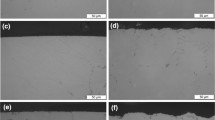We develop new methods of the laboratory defectometry of biocorroded microareas in structural steels based on the quantitative analysis of variations of their roughness. We establish the influence of sulfatereducing bacteria on the microgeometry of surface topography of specimens of 17G1S-U and 20 steels. It was discovered that bacteria are accumulated in microdepressions of the surface, which leads to the formation of mucus and products of their metabolism in these domains followed by the formation of biofilms on the specimen surface. The indicated domains are subjected to the most intense corrosion influence accompanied by the formation of pitting. It was discovered that biocorrosion increases the surface roughness of the investigated steels by a factor of 4.5, which later leads to the localization of stress concentration in these domains.


Similar content being viewed by others
References
E. I. Andreyuk, V. I. Bilai, E. Z. Koval’, and I. A. Kozlova, Microbial Corrosion and Its Causative Agents [in Russian], Naukova Dumka, Kiev (1980).
Ya. A. Serednitskii, V. V. Suprun, and B. S. Bodak, “Microbiological corrosion of steel pipelines and mastic insulating coatings,” Fiz.-Khim. Mekh. Mater., 22, No. 4, 97–101 (1987).
H. A. Videla, “Prevention and control of biocorrosion,” Int. Biodeterior. Biodegrad., 49, 259–270 (2002).
D. Arola and C. L. Williams, “Estimating the fatigue stress concentration factor of machined surfaces,” Int. J. Fatigue, 24, No. 9, 923–930 (2002).
J. Xu, C. Sun, M. Yan, and F. Wang, “Effects of sulfate reducing bacteria on corrosion of carbon steel Q235 in soil-extract solution,” Int. J. Electrochem. Sci., 7, 11281–11296 (2012).
Ya. R. Kim, L. E. Tsygankova, and V. I. Kichigin, “Inhibition of steel corrosion and hydrogenation in model stratal waters,” Korroziya: Mater. Zashch., No. 8, 30–37 (2005).
M. S. Polutrenko, “Anticorrosion and bactericidal properties of the derivatives of dioxodeca-hydroacridine,” Visn. Ternop. Nats. Tekh. Univ., 73, No. 1, 77–84 (2014).
M. S. Polutrenko and A. I. Pilyashenko-Novokhatnyi, “Biostability of corrosion inhibitors – biocides, components of the complex of anticorrosive protection of the linear part of Ukrainian oil-and-gas transport system,” Nauk. Visn. NUBiP Ukr.: Zb. Nauk. Prats, Vyd. NUBiP Ukraine, Kyiv, No. 1(36), 61–65 (2014).
M. S. Polutrenko, “Microbiological corrosion of underground metal structures and means of their protection,” Rozv. Rozrob. Naft. Gaz. Rodov., No. 4 (2012); DOI. http://nbuv.gov.ua/UJRN/rrngr_2012_4_23.
K. Alasvand Zarasvand and V. Ravishankar Rai, “Microorganisms: induction and inhibition of corrosion in metals,” Int. Biodeterior. Biodegrad, 87, 66–74 (2014).
S. M. Lee, W. G. Lee, Y. H. Kim, and H. Jang, “Surface roughness and the corrosion resistance of 21Cr ferritic stainless steel,” Corr. Sci., 63, 404–409 (2012).
S. R. Ignatovich, I. M. Zakiev, and V. I. Zakiev, “Control of the surface quality of articles with the use of a contactless profilometer,” Aviats. Kosm. Tekh. Tekhnol., No. 8, 20–23 (2006).
A. A. Bukharaev, D. V. Ovchinnikov, and A. A. Bukharaeva, “Surface diagnostics with the help of scanning force microscopy (a review),” Zavod. Lab., No. 5, 10–27 (1997).
P. Maruschak, V. Dzyura, O. Prentkovskis, I. Lytvynenko, and M. Polutrenko, “Microdefects of biocorroded pipe steel surfaces and safety assessment of localized stress concentrators,” Metals, 10, No. 7 (2020); 852. DOI:https://doi.org/10.3390/met10070852.
A. L. Tolstikhina, Atomic-Force Microscopy of Crystals and Films with Complex Surface Morphology [in Russian], Doctoral-Degree Thesis (Physics and Mathematics), Moscow (2013).
V. A. Valetov, O. S. Yul’metova, and E. A. Filimonova, “Reliable estimate of the roughness of functional surfaces with the use of microtopographies,” Metalloobrabotka, No. 4, 43–46 (2012.
S. D. Tret’yakov, O. S. Yul’metova, and E. A. Filimonova, “Estimation of the surface roughness according to the three-dimensional topographies,” Izv. Vyssh. Uchebn. Zaved., Priborostroenie, 57, Issue 8, 58–60 (2014).
GOST 9.506-87. Unified System of Protection Against Corrosion and Aging (USPCA). Inhibitors of Metal Corrosion in Water-Oil Media. Methods for the Determination of Protective Ability [in Russian], Izd. Standartov, Moscow (1987).
ISO 4288. Geometrical Product Specification (GPS) – Surface Texture: Profile Method. – Rules and Procedures for the Assessment of Surface Texture, International Organization for Standardization, Geneva (1996).
S. K. Kim and T. A. Kupriyanova, “Problems of microbiological corrosion of oil-field equipment,” Neft. Khoz., No. 3, 62–63 (2001).
ASME B46.1-2009. Surface Texture (Surface Roughness, Waviness, and Lay), ASME, New York (2010).
ISO 4287. Geometrical Product Specification (GPS) – Surface Texture: Profile Method – Terms, Definitions and Surface Texture Parameters, International Organization for Standardization, Geneva, 1997.
P. Maruschak, I. Konovalenko, A. Guzanová, P. Sydor, and S. V. Panin, “Defectometry analysis of surface condition damaged with corrosion pitting,” Mat. Sci. Forum, 818, 153–157 (2015).
Y. Zuo, H. Wang, and J. Xiong, “The aspect ratio of surface grooves and metastable pitting of stainless steel,” Corr. Sci., 44, No. 1, 25–35 (2002).
P. A. Arutyunov, A. L. Tolstikhina, and V. N. Demidov, “System of parameters for the analysis of surface roughness and microrelief of materials in the scanning probe microscopy,” Zavod. Lab. Diagnost. Mater., 65, No. 9, 27–37 (1998).
I. V. Konovalenko, P. O. Marushchak, and L. E. Mosii, “Semantic segmentation of the images of surfaces damaged by pitting corrosion with the help of a convolution neuron network,” in: Proc. of the IV Internat. Sci.-Tech Conf. “Theoretical and Applied Aspects of Radioengineering, Instrument Making, and Computer Technologies,” Dedicated to the 80th Birthday of Prof. Ya. I. Prots’ (June 20–21, 2019) [in Ukrainian], FOP Palyanytsya V. A., Ternopil (2019), pp. 197–199.
Author information
Authors and Affiliations
Corresponding author
Additional information
Translated from Fizyko-Khimichna Mekhanika Materialiv, Vol. 56, No. 5, pp. 110–117, September–October, 2020.
Rights and permissions
About this article
Cite this article
Polutrenko, М.S., Маrushchak, P.О., Bishchak, R.Т. et al. Diagnostics of the Surfaces of 20 аnd 17G1S-U Steels Corrosion Damaged by Sulfate-Reducing Bacteria. Mater Sci 56, 697–705 (2021). https://doi.org/10.1007/s11003-021-00485-7
Received:
Published:
Issue Date:
DOI: https://doi.org/10.1007/s11003-021-00485-7




